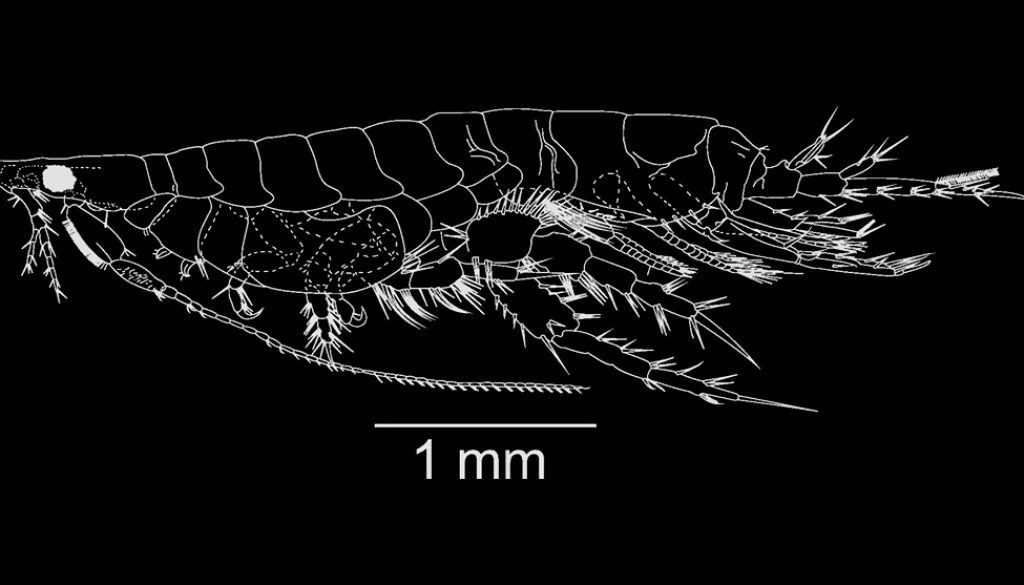Manuel Ortiz, Sergio Cházaro-Olvera *
Universidad Nacional Autónoma de México, Facultad de Estudios Superiores Iztacala, Laboratorio de Crustáceos, Av. de los Barrios 1, 54090 Los Reyes Iztacala, Tlalnepantla, Estado de México, Mexico
*Corresponding author: schazaro@gmail.com (S. Cházaro-Olvera)
Received: 7 December 2020; accepted: 14 August 2021
http://zoobank.org/urn:lsid:zoobank.org:pub:6A66EDD4-8C7A-4499-9013-97F268DDC8DA
Abstract
The genus Eudevenopus includes 4 valid species, inhabitants of relatively shallow waters in both sides of America. A fifth species, collected with a light trap in Sisal, Yucatán Peninsula is described and illustrated in this paper. Eudevenopus winfieldi n. sp. can be distinguished from other species in the genus by the pereopod 7 dactylus, which is as long as propodus, article 1 of flagellum antenna 1 of the male with 2-4 aesthetascs, a comb of 6 distal pectinate setae on the posterodistal margin of the carpus of gnathopod 2, and the uropod 3 peduncle, which has a simple robust intermediate seta on the external margin. An identification key and a comparative table are also provided to contrast the new species from E. honduranus, which is the closest recognised species.
Keywords: New species; Amphipoda; Platyischnopidae; Yucatán Peninsula; Mexico
© 2022 Universidad Nacional Autónoma de México, Instituto de Biología. This is an open access article under the CC BY-NC-ND license
Una especie nueva del género Eudevenopus (Crustacea: Amphipoda: Platyischnopidae) del golfo de México
Resumen
El género Eudevenopus incluye 4 especies válidas, son habitantes de aguas relativamente poco profundas en ambos lados de América. En este artículo se describe e ilustra una quinta especie, recolectada con una trampa de luz en Sisal, península de Yucatán. Eudevenopus winfieldi sp. nov. puede distinguirse de otras especies del género por el dactilo del pereópodo 7, que es tan largo como el própodo, el artejo 1 de la antena 1 del flagelo del macho con 2-4 estetes, un peine de 6 setas pectinadas distales en el margen posterodistal del carpo del gnatópodo 2, el pedúnculo del urópodo 3 tiene una sola seta intermedia robusta en el margen externo. También se proporcionan una clave de identificación y una tabla comparativa para contrastar la especie nueva con E. honduranus, que es la especie reconocida más cercana.
Palabras clave: Especie nueva; Amphipoda; Platyischnopidae; Península de Yucatán; México
© 2022 Universidad Nacional Autónoma de México, Instituto de Biología. Este es un artículo Open Access bajo la licencia CC BY-NC-ND
Introduction
The family Platyischnopidae Barnard & Drummond, 1979, is represented in America by the genera Eudevenopus Thomas & Barnard, 1983 (4 species), Skaptopus Thomas & Barnard, 1983 (1 species), and Tiburonella Thomas & Barnard, 1983 (2 species) (WoRMS, 2020).
The genus Eudevenopus Thomas & Barnard, 1983 currently includes the species: E. capuciatus (Oliveira, 1955), a species from Brazil, recently confirmed as valid by Souza-Filho and Serejo (2012); E. gracilipes (Schellenberg, 1931) (from Valparaíso, Chile); E. honduranus Thomas & Barnard, 1983 (from South Carolina to Venezuela in the Atlantic and from Costa Rica to Ecuador in the Pacific Ocean); and E. metagracilis (Barnard, 1964) (from Northern Baja California to Ecuador in the Eastern Pacific Ocean).
The aim of the present work is to describe a new species of the genus Eudevenopus based on specimens obtained from the Yucatán Peninsula, Mexico.
Materials and methods
The Sisal Coral Reefs form a platform-type reef complex with little limestone growth (Zarco-Perelló et al., 2013). They are located south-east of the Gulf of Mexico between 21º14’00” N, 89º53’23” W and 21º13’55” N, 89º53’24” W. The predominant marine current in this reef complex is the Yucatán Stream, the climate in the coastal zone is of local steppe with average atmospheric temperatures between 25 ºC and 30 ºC, and 3 well-defined seasons: cold storm fronts (“nortes”), dry, and rainy (Zavala-Hidalgo et al., 2014).
The samples were collected at 4 stations on October 18, 2017, from 0.5 m depths. The material was fixed in a 70% solution of ethanol and placed in plastic containers, labelled previously, and transferred to the Crustacean Laboratory of the Facultad de Estudios Superiores Iztacala, Universidad Nacional Autónoma de México (UNAM). Sampling was performed using light traps placed on 3 sites of the Carbonera, a karstic coastal lagoon in north-western Yucatán Peninsula, Mexico, for 1 night, covering a 12 h cycle; all traps had white light of 38 lumens. Traps were constructed from plastic boxes 0.4 m long, 0.25 m wide, and 0.30 m high; a 40 mm diameter inlet holes were made in the upper part of each side of the box (Cházaro-Olvera et al., 2018).
The amphipods were examined, dissected, and illustrated in detail using a camera lucida, and Motic SMZ-168 and BA-210 microscopes. Measurements were made in millimetres (mm) using a digital camera and software (Omax 14MP USB 3). Using Corel Draw V. 12, 102 illustrations were made.
Description
Eudevenopus winfieldi Ortiz & Cházaro-Olvera, 2022
(Figs. 1-5)
http://zoobank.org/NomenclaturalActs/285fcc1a-a4f6-49b3-994b-8cdfd09a8a4f
Diagnosis. Male. Eyes 3.5 X the length of the head, ommatidia black. Antenna 1, article 1 of flagellum with 2 setae and 2-4 aesthetascs. Maxilliped outer plate extending to 0.6 the length of palp article 2, with medial and distal simple setae on inner margin; palp article 4 0.7 X of article 3, with 1 subdistal simple seta; with a bunch of pectinate setae on distal posterior margin of carpus of gnathopod 2; propodus of pereopods 3 and 4 with mid-distal posterior robust simple setae. Basis posterior margin of pereopod 7 with strong notch, dactylus as long as propodus. Epimeron 3 forming a large posteroventral spine. Peduncle of uropod 1 with 1 marginal and 1 subdistal robust simple setae, inner ramus 0.8 X of outer. Uropod 2 peduncle with 2 marginal simple setae, inner ramus 0.7 X of outer. Uropod 3 0.3 X of body length, as long as head and 3 first pereonal segments combined, peduncle lower margin with 1 intermediate and 1 distal simple seta, article 2 of outer ramus 0.8 X of article 1, inner ramus scale-like, with 2 distal plumose setae. Telson with maximum width at half its length, emarginate (40%), lobes without notch, bearing 3 robust apical setae. Female like male but smaller.
Description. Based on male holotype (Fig. 1). Body elongate; head 0.9 X of the 3 first pereonal segments combined, 0.2 X of body length, tip of rostrum cylindrical, with sensorial organ, ventral margin oblique, not excavated; eyes 3.5 X the length of the head, black, round or ovoid in an oblique or vertical position.
Antenna 1 (Fig. 2A). Short, reaching the end of article 4 of antenna 2, peduncle article 1, wider than long (1.8 X), with 1 distal simple seta; article 2, 0.6 X of article 1, with 5 distal simple setae; article 3, 0.8 X of article 2, article 1 of flagellum with 2 simple setae and 2-4 aesthetascs; primary flagellum longer than peduncle (1.5 X), with 5 articles, articles 2-5, 1 simple seta and 1 aesthetasc, accessory flagellum with 3 articles, article 3 with 1 distal aesthetasc. Antenna 2 (Fig. 2B). Long, 0.5 X of body length; article 4, anterior margin completely covered with sensorial setae; article 5, 0.4 X of article 4; anterior margin with 3 groups of small slender simple setae and 1 calceolus; flagellum long, with 37 articles, long, 4 X of peduncle length
(Fig. 1C).
Mandibles (Fig. 3A-C). Molar not triturative; incisor large, poorly dentate; left lacinia mobilis with 5 evanescent teeth; setal row with 5 robust simple setae; right lacinia mobilis tiny; palp article 2, 1.2 X of article 3; with 1 simple subdistal seta; article 3, with 6 long distal setae.
Maxilliped (Fig. 3D-F). Inner plate rectangular, reaching the end of palp article 1, with 2 distal setae; outer plate extending to 0.7 X of palp article 2; palp article 2 with 4 marginal setae; palp article 3 with 3 marginal setae; palp article 4 0.7 X of article 3, with 1 tiny subdistal seta. Upper lip rounded, with thicker cuticle lower margin; lower lip wide and low, without setae; mandibular lobes poorly developed.
Maxilla 1 (Fig. 4A). Inner plate with 1 subdistal plumose seta; outer plate with 8 serrate setae; palp, 0.3 X of outer plate, with 5 distal simple setae. Maxilla 2 (Fig. 4B). Inner plate wider than outer, with 5 long simple setae; outer plate with 1 lateral and 6 distal and long simple setae.
Gnathopod 1 (Fig. 5A). Strongly chelate, shorter than gnathopod 2; coxa 1 subrectangular, posterior margin convex with 4 setae on ventralmargin; basis inflated in the middle zone, with 1 short simple seta, in the middle of anterior margin, and a long simple seta on posterior margin; ischium and merus slender, similar; merus posterior margin with 1 simple seta; carpus as long as merus but slightly wider, with 2 subdistal simple setae on posterior margin; propodus wider proximally; anterior margin with a distal bunch of 4 long simple setae; posterior margin with 5 setae; palm strongly obtuse; margin of dactylus smooth; dactylus fitting palm. Gnathopod 2 (Fig. 5B). Strongly chelate, similar in shape to gnathopod 1; coxa quadrate, with 2 setae in posteroventral corner; basis slender, 4 X as long as wide, both margins parallel, without setae; ischium 1.2 X of merus, naked; carpus as long as ischium; with a bunch of 6 serrate setae on distal posterior margin of carpus; propodus 1.3 X of carpus, with postero-ventral margin inflated, with tiny teeth distally, palm as obtuse as in gnathopod 1; dactylus smooth.
Pereopod 3 (Fig. 5C). Coxa longer than wide (2 X), with 2 simple setae on posteroventral corner; basis as long as merus, naked; ischium with 3 posterodistal simple setae; anterodistal corner of merus with a bunch of 4 setae, posterior margin with 8 long setae; carpus 0.6 X of merus, with 3 simple setae in anterodistal corner, with 1 short and 5 long simple setae on posterior margin, 2 of them inserted parallel to posterior margin of propodus; propodus 1.2 X of carpus, with 5 robust setae on distal part of posterior margin, with 8 middistal posterior robust simple setae; dactylus about 0.5 X of propodus, curved in right angle. Pereopod 4 (Fig. 5D). Coxa 1.5 X wider than long, margin of posterior lobe convex; basis with 3 long simple setae on distal posterior corner and as long as merus; merus inflated in the middle, with 3 simple setae on anterodistal corner, with 9 long simple setae on posterior margin; carpus 0.5 X of merus, with 5 long and 2 robust simple setae on posterior margin, with 2 long simple setae and 1 short simple seta distally; propodus as long as carpus, with 1 short simple seta distally in anterior margin, with 5 short robust simple setae in the distal half of posterior margin, with 1 middistal posterior robust simple setae; dactylus short, 0.5 X of propodus, curved in right angle. Pereopod 5 (Fig. 6A). Coxa wider than long (1.8 X), with strong posteroventral rounded lobe, with 1 simple seta on anteroventral margin and 3 simple setae in posteroventral margin of posterior lobe; basis as long as ischium, merus, and carpus combined, with 2 long simple setae on distal anterior corner; merus forming posterior lobe bearing 8 robust simple setae, anterior margin with a bunch of 3 robust simple setae in the middle and a distal bunch with 7 robust setae; carpus 0.8 X of merus, with 3 robust simple setae in the middle of posterior margin and 4 robust simple setae in the posterodistal corner; anterior margin with 2 bunches of 5 robust simple setae; propodus as long as carpus, slender with 1 robust simple seta on posterior margin, with 2 robust simple setae on anterior margin; dactylus as long as propodus, naked. Pereopod 6 (Fig. 6B). Coxa subquadrate, as wide as long, with a small posterior lobe; basis rounded, with 2 long robust simple setae in anterodistal corner; merus forming a small posterior lobe with a bunch of 6 long robust simple setae, posterior margin with 6 long simple setae, anterior margin with 3 tufts of 3-4 long robust simple setae; carpus 0.7 X of propodus, posterior margin with 3 long robust simple setae, distally with a bunch of 5 setae, anterior margin with 7 long robust simple setae, with a bunch of 4 distal simple setae; propodus 1.4 X of carpus, with 4 intermediate simple setae on posterior margin and with 2 simple setae distally, anterior margin with 3 intermediate robust simple setae, with 3 distally; dactylus 0.8 X of propodus. Pereopod 7 (Fig. 6C). The longest, 1.3 X of pereopod 6, coxa short and wide (2 X), with a tiny simple seta in posteroventral margin; basis as long as wide (1.1 X), with a strong notch on posterior margin (0.1 of pereopod), with 2 robust simple setae in anterior margin, and 2 in anterodistal corner; ischium with 1 robust seta in anterodistal corner; merus as long as basis, width 0.6 X of basis, posterior margin with 8 robust setae, postero distal corner with a bunch of 3 robust simple setae, with 2 additional robust simple setae submarginally; carpus as long as merus, posterior margin with a group of 2 robust simple setae and 2 groups of 3 robust simple setae, anterior margin with 2 groups of 3 simple setae and a group of 2 simple setae on anterodistal corner; propodus 0.8 X of carpus, posterior margin with 3 robust simple setae, posterodistal corner with 3 robust simple setae, anterior margin with 2 robust simple setae, anterodistal corner with 3 robust simple setae; dactylus as long as propodus.


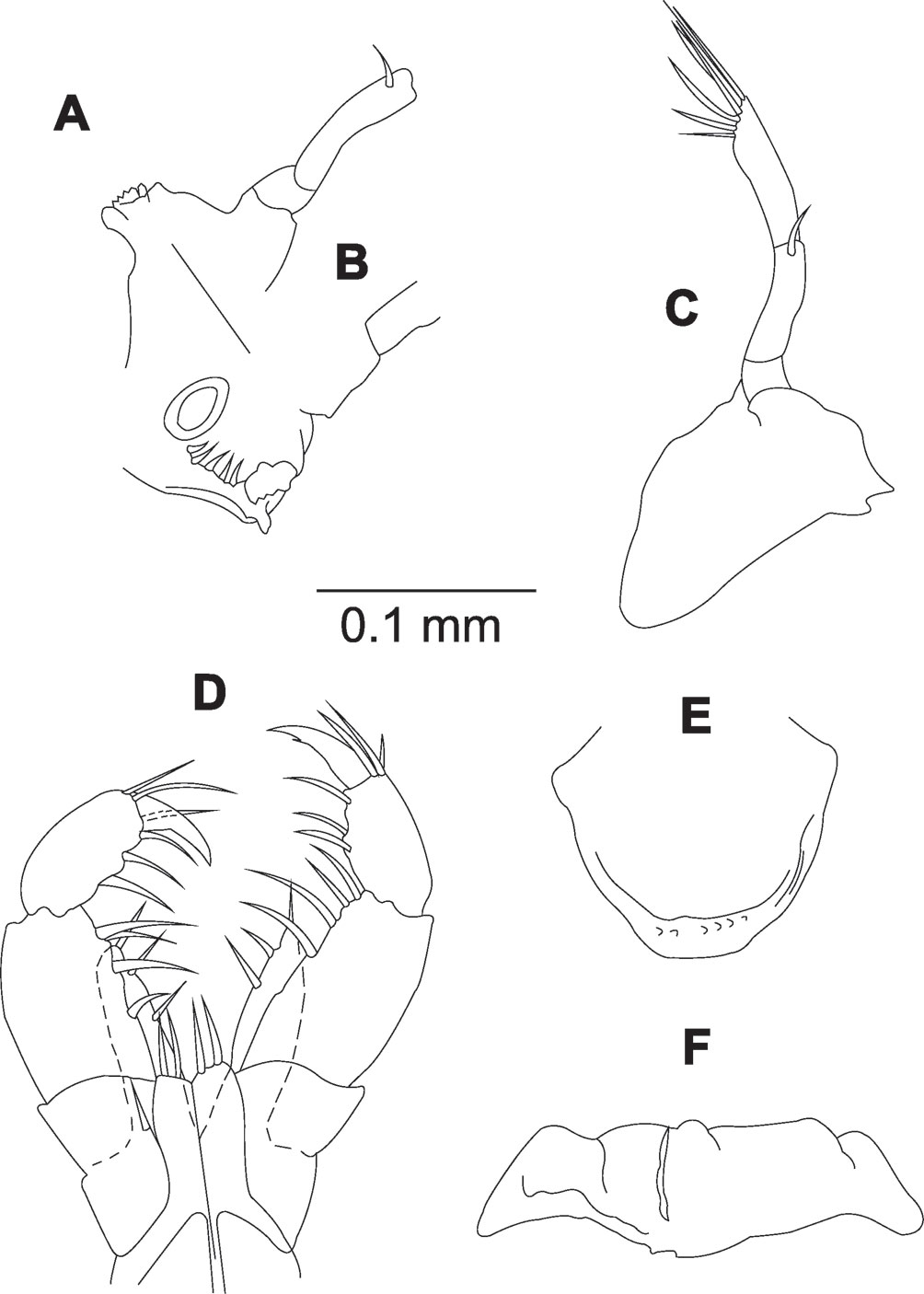
Uropod 1 (Fig. 6D). Peduncle with 1 marginal and 1 subdistal robust simple seta, inner ramus 0.8 X of outer. Uropod 2 (Fig. 7A). Peduncle with 2 marginal simple setae, inner ramus 0.7 X of outer. Uropod 3 (Fig. 7B). Size 0.30 X of body length, as long as head and 3 first pereonal segments combined; peduncle lower margin with 1 intermediate and 1 distal simple seta; article 2 of outer ramus 0.8 X of article 1; inner ramus scale-like, with 2 distal plumose setae.
Telson (Fig. 7C). Maximum width at half of its length, emarginate (40%), lobes without notch, bearing 3 robust apical simple setae, lateral margins with 1 middle brush of 2-3 long simple setae.
Epimerons (Fig. 7D). Epimeron 1 with 4 posteroventral long plumose setae. Epimeron 2 naked. Epimeron 3 ventral margin with 3 simple setae, posterodistal spine well developed.
Ovigerous female. Similar to male, smaller (2.8 mm); eyes similar to male; antenna 1 flagellum of 4-6 articles; antenna 2 anterior margin of article 4 with 4-5 bunches of short simple setae; flagellum of 5 articles (Fig. 8A ); propodus of pereopod 3 with 8 simple setae in distal half (Fig. 8B); propodus of pereopod 4 with 7 simple setae in distal half (Fig. 8C); pereopods 5-7 with dactylus as long as propodus (Fig. 9A-C); uropod 3 peduncle with 1 robust simple seta on outer margin; margin of first article of outer ramus with 4-5 bunch of 3-4 simple setae (Fig. 9D); epimeron 1 with 4 plumose setae 3 of them in posterodistal corner; epimeron 2 with 2 setae on ventral margin; epimeron 3 posterodistal spine well developed (Fig. 9E).

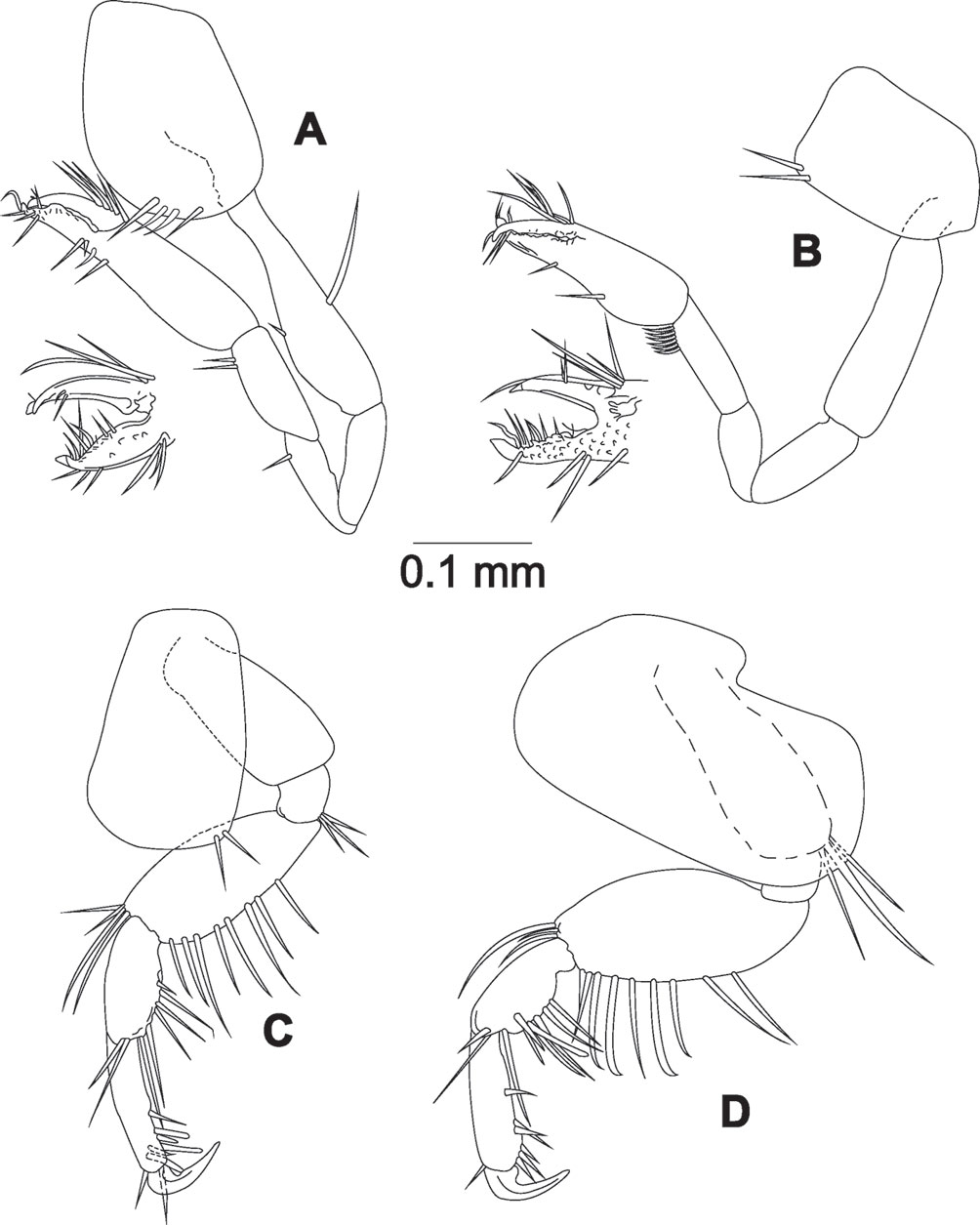
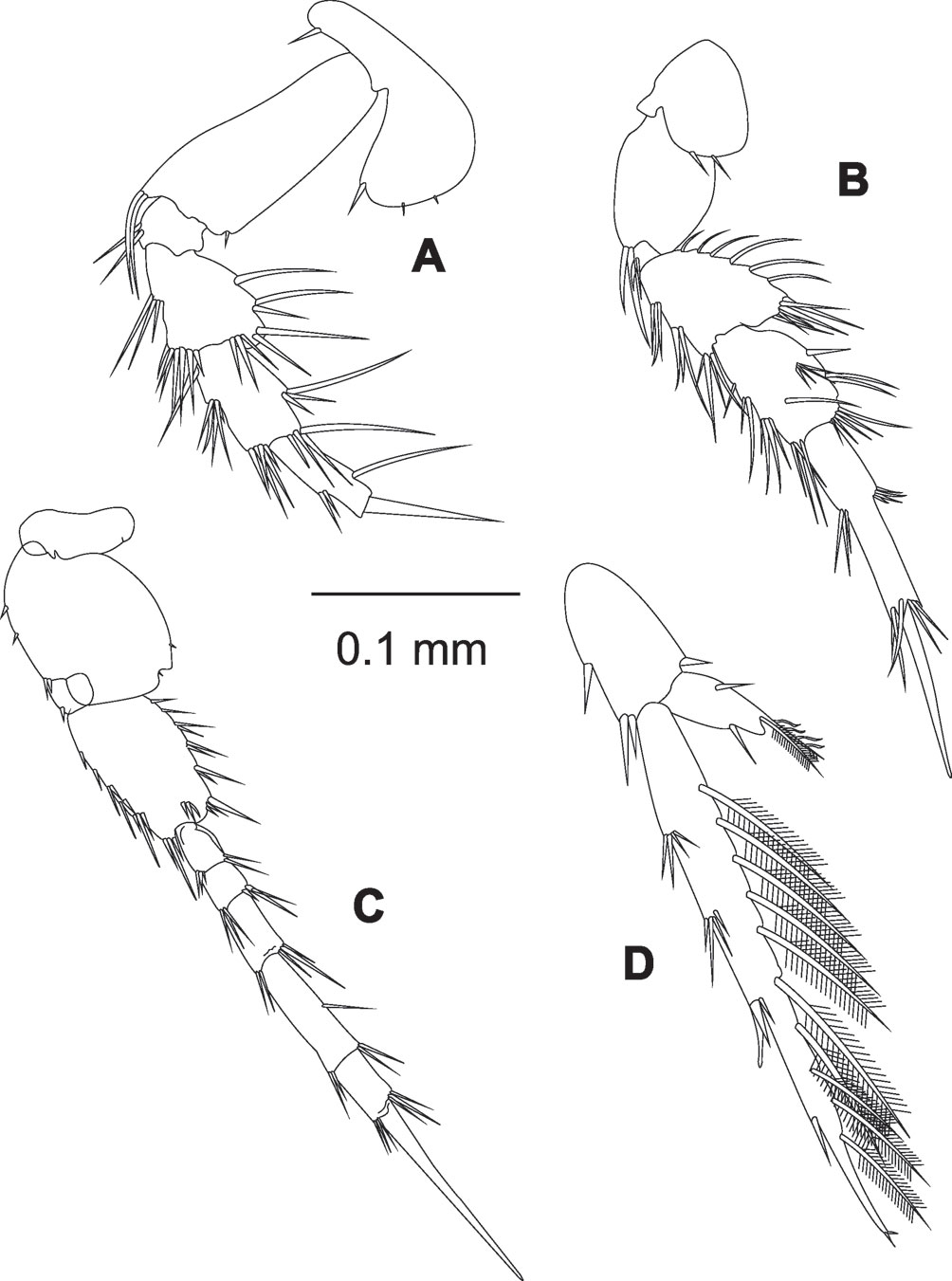
Taxonomic summary
Material examined. The specimens were collected by the second author, during a benthic sampling program at Sisal, North-western Yucatán Peninsula.
Etymology. The new species is named to honour Dr. Ignacio Winfield Aguilar, our colleague and friend at the Crustacean Laboratory, Facultad de Estudios Superiores Iztacala, UNAM.
Holotype. Male, 3.4 mm; deposited at the Colección Nacional de Crustáceos, Facultad de Biología, Universidad Nacional Autónoma de México; No. CNCR 35104.
Allotype: female, 2.8 mm; collected and deposited next to the holotype; No CNCR 35105. Partypes: 2 males, 3.4 mm; No. CNCR 35106.


Remarks
From the description of E. winfieldi sp. nov. presented above and the descriptions of other species by Thomas and Barnard (1983) and Souza-Filho and Serejo (2012), the characteristics for differentiation of species of the genus Eudevenopus can be established: the size of the notch on the posterior margin of the basis (the first criterion for separation of Eudevenopus species used in this study) and the size of the dactylus and propodus of pereopod 7; the size of the peduncle of uropods 1 and 2; the number of combs of setae on article 2 of uropod 3; presence of a bunch of pectinate setae on distal posterior margin of carpus of gnathopod 2; number of aesthetascs in article 1 of flagellum of antenna 1; presence of a set of setae intermediate on outer margin of peduncle of the uropod 3; size of the spine on outer plate, posteroventral in epimera 2-3 —this character is the first criterion used by Thomas and Barnard (1983) and Souza-Filho and Serejo (2012) for separation of Eudevenopus species —; number of setae on ventral margin of epimeron 2; length of the inner ramus of uropod 2; form of the telson lateral margins.
For differentiation of the species in the key elaborated in this work and presented next we consider that the basis of pereopod 7 in the species E. gracilipes has a weak notch on the posterior margin and the peduncle of uropods 1 and 2 are longer than the rami (1.1 X). Thomas and Barnard (1983) reported that in E. gracilipes the inner and outer rami of uropod 2 have 1 dorsal spine and article 2 of the outer ramus of uropod 3 has 1 X 2 spine. Souza-Filho and Serejo (2012) mentioned that in uropod 3 article 2 of the outer ramus has 1 comb of robust setae.
The other species of Eudevenopus have a basis with a strong notch on the posterior margin and the peduncles of uropods 1 and 2 shorter than the rami (0.8 X). The dactylus of pereopod 7 is longer than the propodus; telson is with lateral margins parallel or widening backward. The species E. metagracilis presents a maxilliped outer plate reaching end of palp article 2; epimera 2-3 produced into a small posteroventral spine; ventral margin of epimeron 2 with setae; uropod 2 inner ramus about 0.66 of outer ramus; telson with lateral margins parallel. Whereas E. capuciatus presents the maxilliped outer plate reaching 0.5 of palp article 2; epimera 2-3 produced into a strong posteroventral spine, ventral margin of epimeron 2 lacking setae; inner ramus of uropod 2 about ¾ of outer ramus; telson widened backward.
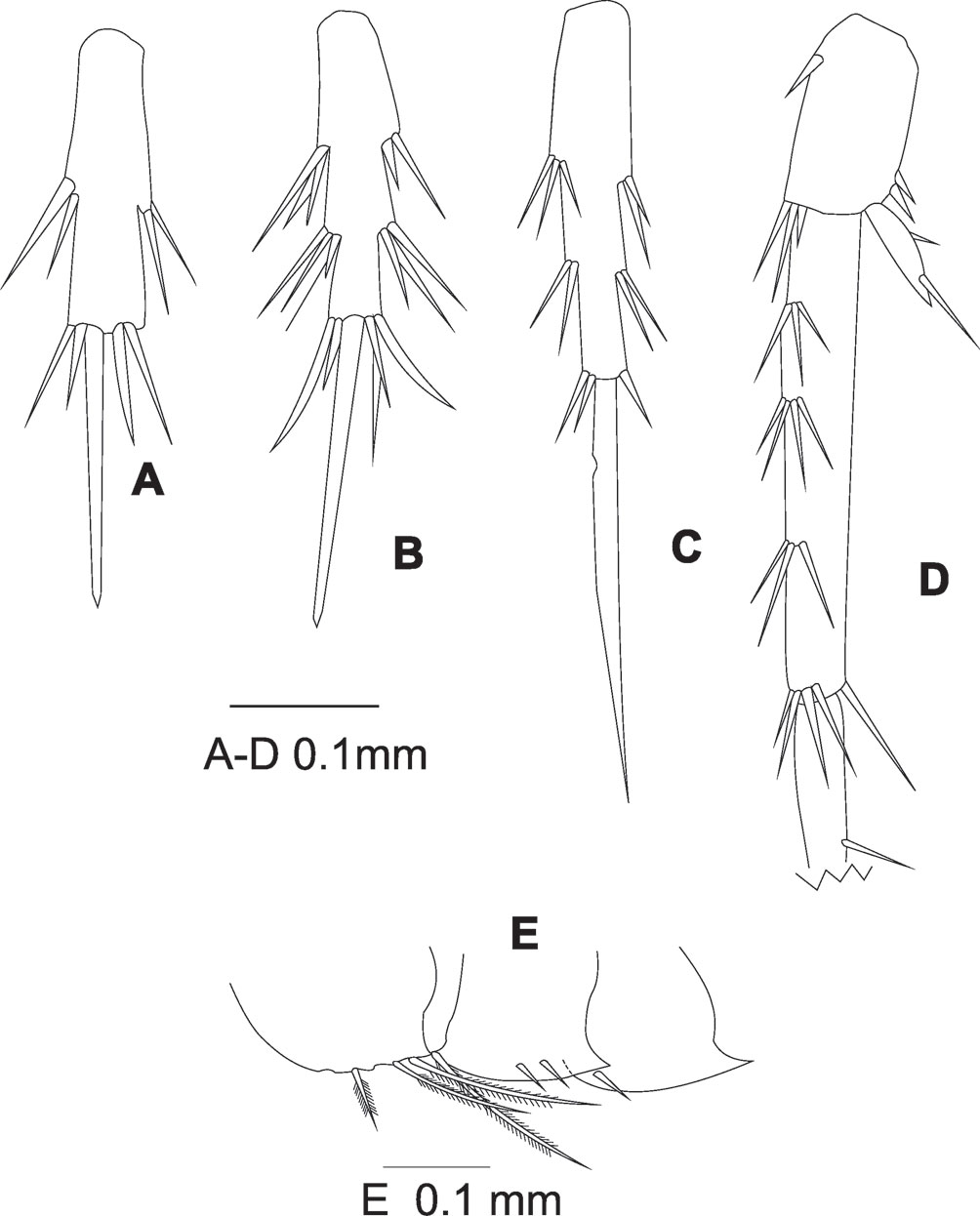
The species E. honduranus and E. winfieldi are similar morphologically and share a distribution in American waters so in attempting differentiation we must consider certain characteristics: in E. honduranus pereopod 7 dactylus is shorter (0.6) than propodus; without a bunch of pectinate setae on distal posterior margin of carpus of gnathopod 2 (as pectinate spines, after Thomas & Barnard, 1983); antenna 1 article 1 of flagellum with 9 aesthetascs; uropod 3 outer margin of peduncle with a set of 3 intermediate setae. In the case of E. winfieldi, the pereopod 7 dactylus as long as propodus; a bunch of pectinate setae present on distal posterior margin of carpus of gnathopod 2; antenna 1 article 1 of flagellum with 2 setae and 2-4 aesthetascs; uropod 3 outer margin of peduncle with 1 intermediate seta. In addition, we found other characteristics for differentiation between those 2 species (Table 1).
However, E. honduranus is very widely distributed in the Atlantic Ocean, from South Carolina to Venezuela, and in the Pacific, from Costa Rica to Ecuador, and it is also considered as probably present in the waters of Chile (Thomas & Barnard, 1983).
Table 1
Morphological comparison between E. honduranus and E. winfieldi.
| Sex | Character | E. honduranus | E. winfieldi |
| Male | Aesthetascs in antenna 1 | 9 in article 1 of flagellum | 2-4 in article 1 of flagellum |
| Outer plate maxilliped reaching | 0.5 palp article 3 | 0.7 palp article 3 | |
| Bunch of pectinate setae on distal posterior margin of carpus of gnathopod 2 | Absent | Present | |
| Pereopod 6, dactylus | 0.6 X of propodus | 0.8 X propodus | |
| Pereopod 7, dactylus | 0.6 X as long as propodus | Equal to propodus | |
| Epimera 2-3 posteroventral corner produced into a | Long spines | Epimera 2 naked, Epimera 3 long spines | |
| Uropods 1 and 2 peduncles | Shorter than rami | Shorter than rami | |
| Uropod 1 peduncle | With 2 subdistal robust setae | With 1 distal robust seta | |
| Uropod 2 inner ramus | 0.7 X of outer ramus | 0.7 X of outer ramus | |
| Uropod 3 article outer ramus | 0.8 X of article 1, 3 combs of robust setae | 0.8 X of article 1, With 2 distal plumose setae | |
| Uropod 3 peduncle outer margin | With an intermediate set of 3 setae | With 1 intermediate seta | |
| Female | Antenna 2 article 4 anterior margin | Completely covered with comb of setae | With 4-5 bunch of setae |
In conclusion, E. winfieldi can be distinguished from other species in the genus by observing the dactylus of pereopod 7 as long as propodus; article 1 of flagellum antenna 1 (of male) with 2-4 aesthetascs; a comb of 6 distal pectinate setae in the posterodistal margin of the carpus of gnathopod 2, and uropod 3 peduncle with a single robust intermediate seta in the external margin. In addition, E. windfieldi has a more western distribution in the Gulf of Mexico, constituting the first record of the genus in the north-western part of the Yucatán Peninsula.
Key to species of the genus Eudevenopus (adapted from Souza-Filho and Serejo [2012]).
1. Pereopod 7 basis with a weak notch on posterior margin; uropod 1 and 2 peduncle longer than rami
(1.1 X)…………………………………………………………………………………… E. gracilipes
– Pereopod 7 basis with a strong notch on posterior margin; uropod 1 and 2 peduncle shorter than rami
(0.8 X)…………………………………………………………………………………… 2
2. Pereopod 7 dactylus short (0.6 X) or as long as propodus; telson with maximum width at half its length…………………………………………………………………………………… 3
– Pereopod 7 dactylus longer than propodus; telson with lateral margins parallel or widened backward…………………………………………………………………………………… 4
3. Pereopod 7 dactylus short (0.6 X) of propodus; bunch of pectinate setae on distal posterior margin of carpus of gnathopod 2 absent (as pectinate spines, after Thomas and Barnard, 1983, page 5); antenna 1 article 1 of flagellum with 9 aesthetascs; Outer plate maxilliped reaching 0.5 palp article 3; Uropod 1 peduncle whit 2 subdistal robust setae; uropod 3 outer margin of peduncle with a set of 3 intermediate setae…………………………………………………………………………………… E. honduranus
– Pereopod 7 dactylus as long as propodus; bunch of pectinate setae on distal posterior margin of carpus of gnathopod 2 present; antenna 1 article 1 of flagellum with 2 setae and 2-4 aesthetascs; Outer plate maxilliped reaching 0.7 palp article 3; Uropod 1 peduncle whit 1 subdistal robust setae; uropod 3 outer margin of peduncle with 1 intermediate seta…………………………………………………………………………………… E. winfieldi n. sp.
4. Maxilliped outer plate reaching end of palp article 2; epimera 2-3 produced into a small posteroventral spine; ventral margin of epimeron 2 with setae; uropod 2 inner ramus about 2/3 of outer ramus; telson with lateral margins parallel…………………………………………………………………………………… E. metagracilis
– Maxilliped outer plate reaching 0.5 X of palp article 2; epimera 2-3 produced into a strong posteroventral spine, ventral margin of epimeron 2 lacking setae; uropod 2 inner ramus about 3/4 of outer ramus; telson widened backward…………………………………………………………………………………… E. capuciatus
As E. honduranus and E. winfieldi are the closest species, both morphologically and because of their distribution in American waters, Table 1 presents a comparison of these species.
Acknowledgments
To the authorities of Conapesca-DGOPA from the Agriculture and Fisheries Secretaria (Sagarpa) for the permits granted (PPF/DGOPA-051/15). We also thank the students that helped in the collection of specimens. To the PASPA program of the UNAM for the support given to the second author during the sabbatical stay at ITBOCA, where the present work was concluded.
References
Barnard, J. L. (1964). Los anfípodos bentónicos marinos de la costa occidental de Baja California. Revista de la Sociedad Mexicana de Historia Natural, 24, 205–273.
Barnard, J. L., & Drummond, M. M. (1979). Gammaridean Amphipoda of Australia, Part IV. Smithsonian Contributions to Zoology, 269, 1–69.
Cházaro-Olvera, S., Robles, R., Montoya-Mendoza, J., & López-Herrera, J. A. (2018). Intraspecific variation in megalopae of Clibanarius antillensis (Anomura, Diogenidae) among western Atlantic populations. Nauplius, 26, e2018031. https://doi.org/10.1590/2358-2936e2018031
Oliveira, L. P. H. (1955). Phoxocephalus capuciatus, nova espécie de Crustácea Amphipoda, Phoxocephalidae. Rio de Janeiro. Memórias do Instituto Oswaldo Cruz, 53, 313–319. https://doi.org/10.1590/s0074-02761955000200009
Schellenberg, A. (1931). Gammariden und Caprelliden des Magellangebietes, Sudgeorgiens und der Westantarktis. Further Zoological Results of the Swedish Antarctic Expedition 1901-1903, 2.
Souza-Filho, J. F., & Serejo, C. (2012). Redescription and designation of a neotype for Eudevenopus capuciatus (Oliveira, 1955) (Crustacea: Amphippoda: Platyischnopidae) from Brazilian waters, with comments on its cuticular ultrastructures. Cahiers de Biologie Marine, 53, 469–484.
Thomas, J. D., & Barnard, J. L. (1983). The Platyischnopidae of America (Crustacea, Amphipoda). Smithsonian Contributions to Zoology, 375, 1–33.
Zarco-Perelló, S., Mascaró, M., Garza-Pérez, R., & Simoes, N. (2013). Topography and coral community of the Sisal Reefs, Campeche Bank, Yucatán, México. Hidrobiológica, 23, 28–41.
Zavala-Hidalgo, J., Romero-Centeno, R., & Mateos-Jasso, A. (2014). The response of the Gulf of Mexico to wind and heat flux forcing what has been learned in recent years. Atmósfera, 27, 317–334. https://doi.org/10.1016/S0187-6236(14)71119-1
WoRMS Editorial Board. (2020). World register of marine species. Available at: htth://www.marinespecies.org.at VLIZ. Accessed 2020-01-25. https://doi.org/10.14284/170

